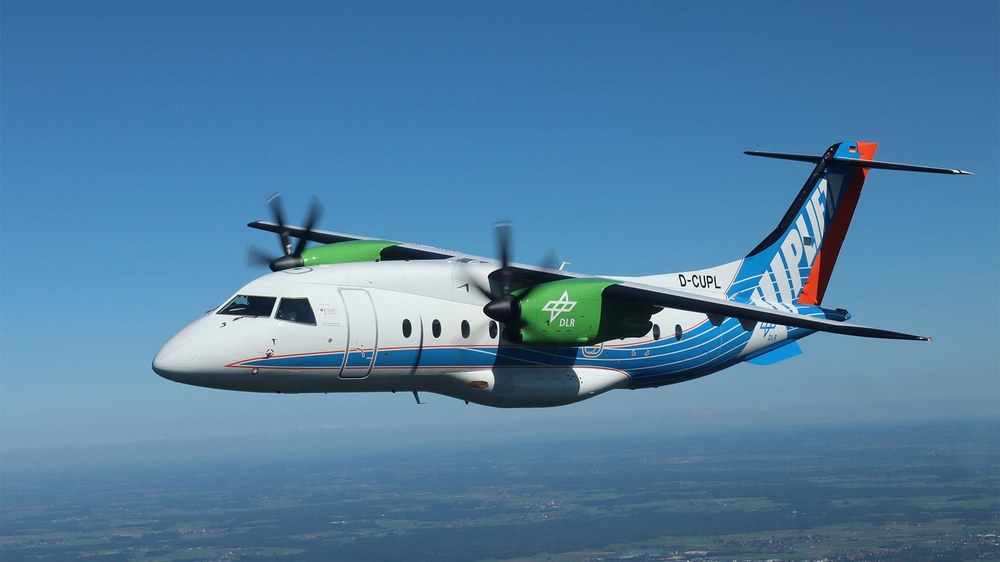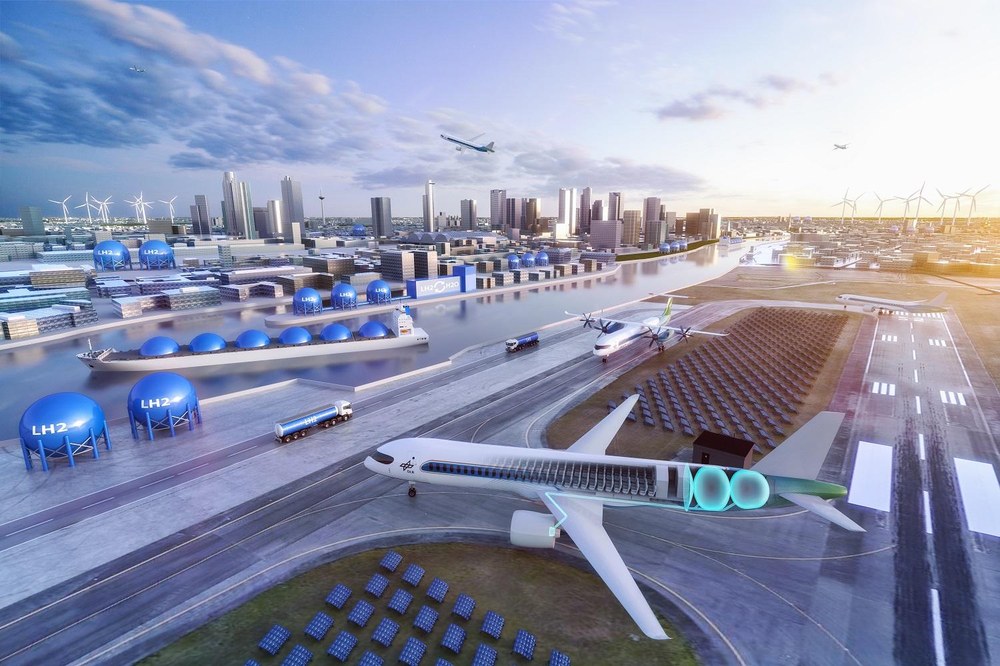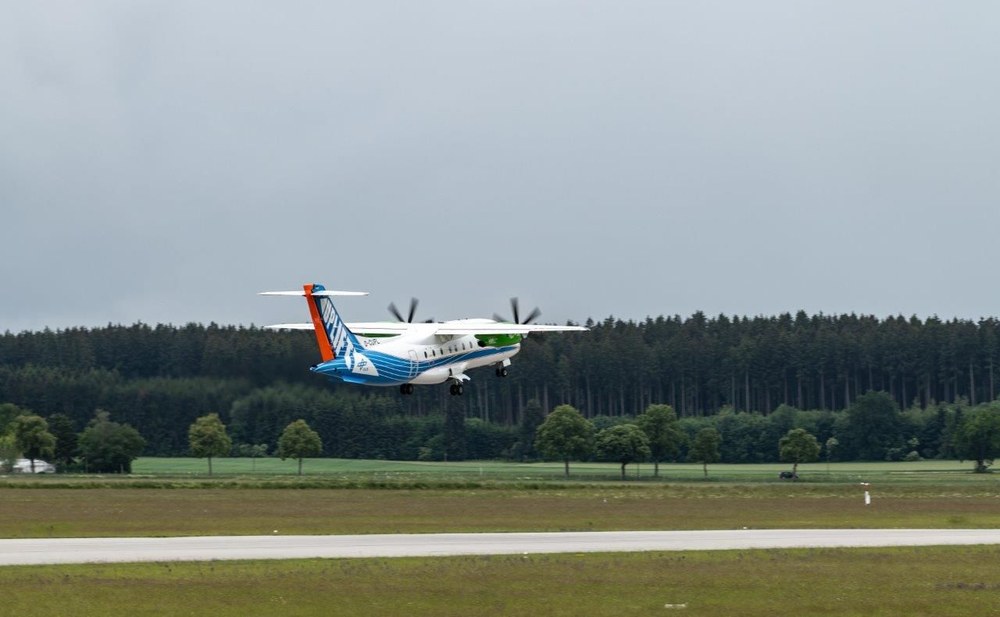DLR at ILA Berlin 2024



- DLR is the largest institutional exhibitor at ILA Berlin 2024.
- The new DLR research aircraft D328 UpLift will be on display at ILA for the first time. Following a successful test flight on 28 May 2024, UpLift will fly to ILA using 100 percent synthetic fuel.
- DLR's SPACEBUZZ ONE will be making its world premiere.
- Climate-compatible aviation, spaceflight using quantum technologies in orbit and security research are taking centre stage at the DLR stand.
- Representatives from the DLR Executive Board and DLR research will provide insights into current missions and projects during discussions on the stage at the DLR stand.
- There will be a wide range of exhibits and an extensive stage and event programme in the Space Pavilion.
- Focus: Aeronautics, space, security, innovation, transfer
ILA Berlin, a leader in the fields of innovation, new technologies and sustainability, draws the global aerospace industry to the heart of Europe every two years. In 2024, the motto of the trade fair will be 'Pioneering Aerospace for a safe, sustainable and connected world'. From 5 to 9 June, the German Aerospace Center (Deutsches Zentrum für Luft- und Raumfahrt; DLR) will be the largest institutional exhibitor, presenting pioneering technologies and concepts for climate-compatible aviation, space technologies for Earth observation and exploration, particularly in the field of quantum physics, as well as new approaches in the field of security research. The 500-square-metre DLR stand in Hall 4 (Stand 300), the Space Pavilion (Hall 4) and the stand of the Federal Ministry for Economic Affairs and Climate Action (BMWK) in Hall 2 (Stand 220) will provide a wide range of insights into the latest research activities. Aircraft from DLR's research fleet will be on display on the ILA grounds. For the first time, DLR will be presenting the new D328 UpLift research aircraft, a 'flying testbed' for climate-friendly aviation technologies, which will fly to this year's ILA using 100 percent synthetic fuel. DLR's SPACEBUZZ ONE will also be making its world premiere. All information on DLR's presence, exhibits and dates can be found on DLR's dedicated ILA Berlin 2024 website.
"For DLR as a German research and technology centre, the ILA is the leading international trade fair for aerospace. The intensive exchange of knowledge offers us extensive opportunities to engage in discussions about new projects and missions. Thanks to our close cooperation with industry and business, accompanied by strong support from policymakers, we are in a position to use our technologies to strengthen Germany's position as a prime location business and science," emphasises Anke Kaysser-Pyzalla, Chair of the DLR Executive Board. "Together, we are paving the way for climate-compatible aviation. Utilising spaceflight enables us to quantify emission sources and determine their impact on climate change. We are also combining our expertise in aeronautics and space with our expertise in energy, transport and digitalisation, enabling us to unleash DLR's potential for security and defence research."
Aeronautics – Technologically open to climate-compatible aviation
The DLR Aviation Strategy charts the path towards climate-compatible aviation in the second half of this century. To this end, DLR is conducting open-technology research together with the national and international aviation industry and academia across the entire spectrum: from aircraft concepts and components to low-emission propulsion solutions in combination with sustainable energy sources all the way to climate-optimised flight routes and regulatory measures. Simulation-based development and certification enables possible aircraft designs to be researched faster and with a lower risk than is currently possible and leads to faster market introduction of new technologies. With the ALICIA (Aviation Life Cycle and Impact Assessment) assessment tool, it is possible for the first time to analyse the overall systemic interaction and assess the most important factors that influence the climate, energy requirements and added value over the entire life cycle of an aircraft. DLR is presenting this far-reaching tool to the public for the first time. Visitors can use a dashboard to explore the diverse possibilities of the climate-compatible aviation of tomorrow. In addition, the H2ELECTRA aircraft model at the DLR stand visualises the great technical challenges involved in electrifying a regional aircraft with around 50 passengers using a fuel cell and hydrogen as well as possible solutions. Electricity-based synthetic fuels (SAF, Sustainable Aviation Fuel) and optimised flight routes are very promising approaches for larger passenger aircraft in the short and medium term in order to rapidly increase the climate compatibility of aviation.
DLR research aircraft D328 UpLift makes its debut at ILA 2024
One of the highlights of this year's ILA is the new DLR research aircraft D328 UpLift, which will be presented to the general public for the first time in the centre of the exhibition grounds – the ILA Plaza. The D328 will be used as a flying test laboratory for climate-compatible aviation technologies, such as fully synthetic fuels or hydrogen as a possible sustainable aviation fuel of the future. It will fly to the ILA in Berlin using 100 percent synthetic fuel. More specifically, it is an aromatic-free Fischer-Tropsch fuel that can be produced in future using green hydrogen and a sustainable carbon dioxide source as power-to-liquid (PtL). The fuel used in UpLift is chemically and process-technically equivalent to the PtL that will be available in the future ('PtL proxy'). On 28 May 2024, UpLift completed its first test flight at the DLR site in Oberpfaffenhofen powered by 100 percent of this PtL-proxy on one engine, thus preparing for the operation of both engines with PtL-proxy. The combustion of this fuel is expected to reduce the emission of soot particles and the climate impact of contrails. An extensive flight test campaign with UpLift in the coming months is intended to confirm this for regional aircraft using the D328 as an example and to investigate the overall environmental impact of synthetic fuels during real operations. According to current calculations, the use of PtL can reduce carbon dioxide emissions in the overall balance of a flight by up to 95 percent. The D328 UpLift flying test laboratory will be used by industry, SMEs and start-ups as well as research institutions to test new, climate-compatible system, fuel and propulsion technologies under real-life conditions and significantly accelerate their deployment in aviation. DLR operates the largest civilian fleet of research aircraft in Europe. The Cessna Grand Caravan, DLR's 'flying auditorium', and the DLR BO-105 helicopter, which is celebrating 50 years of research operations this year, will also be on display at the ILA outdoor exhibition area.
Spaceflight – Quantum technologies in orbit
Space technologies are an indispensable part of our everyday lives due to their use in satellite communications, satellite navigation and Earth observation. Quantum technologies are based on quantum physics and will not only significantly improve space-based applications in the coming years, but also enable further innovations. To this end, DLR will be showcasing the variety of applications and technologies that now need to be brought out of the laboratory and into application at an exhibition island on the DLR stand. These include quantum sensors for Earth observation, quantum keys for tap-proof satellite communication and highly stable optical clocks suitable for use in space, such as the iodine clock, which is to be tested on the Bartolomeo platform of the International Space Station ISS as part of the COMPASSO project. Due to their outstanding stability, these clocks have the potential to improve the accuracy and resilience of positioning with navigation satellites and provide an excellent foundation for high-precision global timekeeping and future scientific missions.
In addition, fundamental physical theories such as the theory of relativity can be tested using new quantum experiments in space, for example with the BECCAL experimental facility for the ISS, where German and US research into ultracold atoms and Bose-Einstein condensates is to be conducted jointly. Finally, quantum computers and quantum algorithms, also in conjunction with artificial intelligence, harbour potential for space-related applications. The DLR Quantum Computing Initiative is contributing to this.
Security research – Strengthening internal and external security
DLR stands for research and technology development in aeronautics and space, energy and transport, as well as in civil security and defence research. The results of DLR's work in this core area are utilised by the Federal Ministry of Defence, the German Armed Forces, security authorities and industry. As part of interdisciplinary projects and with four security research institutes, DLR makes a wide range of contributions to the development, testing and evaluation of security and defence-related technologies. At ILA 2024, DLR is presenting the Space Situational Awareness Centre, the Future Fighter Demonstrator (FFD) – a concept study of a modern, highly agile next-generation fighter aircraft – and the small satellite mission OTTER (Optical Traffic Tracking Experiment for Responsive Space), an experiment that includes the planning, integration, launch and operation of a mission with the aim of realising space-based capabilities in the future in a responsive manner (Responsive Space).
One-of-a-kind – The ILA Space Pavilion
Sustainability and climate protection, digitalisation and commercialisation, innovation, international collaboration in exploration and research as well as the protection of our critical infrastructure and security are the key topics at ILA's unique ‘Space Pavilion’ in Hall 4. Here, under the motto 'Space for Earth', DLR, the European Space Agency (ESA), the German Federal Ministry for Economic Affairs and Climate Action (BMWK) and the German Aerospace Industries Association (BDLI) will be demonstrating on 1500 square metres that space research and space applications have long since become part of our everyday lives and that there is a lot more to them than mere fascination. The extensive stage and event programme with high-profile participants focuses on the benefits of spaceflight for life on Earth as well as the latest trends. DLR is responsible for 22 of the 51 exhibits in the Space Pavilion. The range of topics includes Earth observation and satellite communications, cooperation on the ISS and the return to and exploration of the Moon, innovative technologies from spaceflight for other sectors and the protection of our home planet from dangers from space, specifically the Hera asteroid defence mission.
Spaceflight plays a central role in the fight against climate change: Earth observation satellites such as the Sentinels from the European Copernicus programme, the European environmental satellite EarthCare launched on 29 May 2024, but also national missions such as the German-American climate mission Grace to measure the Earth's gravitational field provide highly precise and long-term data sets. The Space Pavilion will also be focussing on current megatrends in spaceflight. This primarily refers to its commercialisation and integration with other sectors such as the automotive and agricultural sectors. Another aspect is the contribution of spaceflight to security and defence. Research on the International Space Station ISS will also be presented. It enables progress in medicine and technology and facilitates technology transfer in many sectors.
SPACE BUZZ ONE and Airbus A310 ZERO-G
DLR's SPACEBUZZ ONE is celebrating its world premiere at the ILA: SPACEBUZZ ONE is a key project of the German Space Agency at DLR and is aimed at schoolchildren aged eight and over as well as adults. In the rocket-shaped lorry, nine people can simultaneously experience a 15-minute virtual flight around Earth all the way to the Moon and back with the German ESA astronauts Alexander Gerst and Matthias Maurer and learn many interesting facts about our home planet and the fascination and benefits of spaceflight. The DLR SPACEBUZZ ONE is located in front of Hall 4 next to the Ariane 6 launcher model. The Airbus A310 ZERO-G from the French company Novespace will also be a featured guest at the static display from 7 to 9 June. The A310 ZERO-G has been used for microgravity flights and thus also for DLR's parabolic flight campaigns since 2015. From 27 May to 6 June 2024, the 42nd DLR parabolic flight campaign will take place at the A310 ZERO-G's home base in Bordeaux. The aircraft and crew will travel to the ILA in Berlin immediately thereafter.
From science to application – technology, innovation and transfer at DLR
DLR is the birthplace and driving force behind many technological developments that are currently being used in aerospace and which will shape our future: Optimised flight routes, efficient and quiet engines and solutions for emission-free aviation are just as much a part of this as robotic arms for working in space and Earth observation satellites. At DLR, new technologies, ideas and valuable knowledge are created every day. Together with partners from industry - from start-ups and small and medium-sized enterprises to global players – DLR realises this potential in innovations, transfer projects and spin-offs. The aim is to make industry successful through research. For this to work, scientific results must be made scalable and usable, in other words, they must make their way from the laboratory to real-life applications. To this end, DLR develops and operates around 180 large-scale research facilities, such as research aircraft, wind tunnels, test stands for rocket engines and test fields for fuel cell systems. Successful spin-offs from DLR in the fields of robotics, solar fuels, laser communications and materials development show that this technology transfer is effective.
Live talks on the stage at the DLR stand
This year, the DLR stand has a stage. DLR will be presenting a varied programme there during the trade fair: In moderated talks, representatives from DLR's Executive Board and research will provide insights into current projects and missions - on site and via live stream on DLR's YouTube channel. DLR will also be reporting daily from ILA on X and Instagram.
Dates for the press
Thursday, 6 June 2024, 14:15-14:45, DLR stand in Hall 4 (Stand 300)
Press conference on the results of the ECLIF3 flight test campaign
As part of the ECLIF3 (Emission and Climate Impact of Alternative Fuels) study, emissions measurements were carried out for the first time in the world on a large commercial aircraft powered by 100 percent sustainable aviation fuel (SAF) on both engines. To do this, the DLR Falcon 20E measurement aircraft flew behind an Airbus A350 in its exhaust jet. The emission measurements show promising results, which will be presented jointly at the press conference by the project participants DLR, Airbus, Rolls-Royce and Neste.
Friday, 7 June 2024, 10:15-10:45, Static Display
Photo opportunity with statements and tour of '50 years of the DLR BO 105 research helicopter'
DLR's BO 105 helicopter celebrates 50 years of research in 2024. After entering service in 1974, the helicopter was extensively modified for research purposes at DLR and has since been used in many different helicopter projects. For example, it is particularly suitable for flight characteristics tests, as a camera carrier for thermal imaging cameras, for the investigation of quieter approaches, the development of pilot assistance systems or flights with external loads. To mark the anniversary, DLR is offering a photo opportunity with statements from DLR Divisional Board Member for Aeronautics Markus Fischer and Uwe Göhmann, DLR research pilot. A tour of the research helicopter will follow, and there will be an opportunity for interviews.
